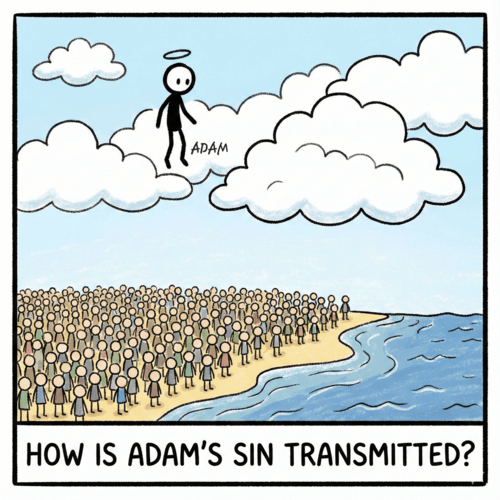How Is Original Sin Transmitted? A Reformed Perspective
Federalism vs. Seminalism: What Does the Bible Teach?
How is original sin—Adam’s first transgression—transmitted to us? How are we implicated? This is a profound theological question facing the church. Two main views have emerged within Reformed theology: federalism and seminalism. Federalism emphasises Adam’s role as our covenant representative—his actions legally bind his posterity. Seminalism, by contrast, suggests Adam’s sin is transmitted physically through natural generation.
The question is far from merely academic: our understanding of how we inherit Adam’s guilt directly impacts our comprehension of Christ’s work, the nature of salvation, and the justice of God in condemning all humanity in Adam. The Reformed tradition has historically emphasised federal headship while recognising certain natural consequences of the Fall.
BIBLICAL FOUNDATION FOR THE FEDERAL VIEW
Adam as Covenant Head: The federal view finds its strongest support in Paul’s parallel between Adam and Christ in Romans 5:12-21. Here, Paul presents Adam not merely as our natural ancestor but as our covenant representative. The crucial phrase ‘because all sinned’ (Romans 5:12) underscores the Adam-Christ parallel, showing how one person’s actions can determine the status of many.
Paul reinforces the federal framework in 1 Corinthians 15:22: “For as in Adam all die, so also in Christ shall all be made alive.” The parallel only makes sense within a federal framework, as Christ’s righteousness is clearly imputed to us through representation rather than physical descent. The pattern of federal headship permeates Scripture’s covenantal structure. Adam stands as the head of humanity in the covenant of works, just as Christ stands as the head of the new humanity in the covenant of grace.
Biblical Covenantal Framework: Scripture consistently presents God as dealing with humanity through covenant representatives. Noah represented his family in God’s covenant, Abraham stood as federal head for his seed, and most significantly, Christ represents His elect in the covenant of grace. This pattern of federal representation is central to God’s redemptive plan and appears consistently throughout Scripture.
UNDERSTANDING SEMINALISM
The Augustinian Heritage: Seminalism finds its classical expression in Augustine’s writings. He argued all humanity was ‘seminally’ present in Adam when he sinned, and therefore, each of us literally participated in his transgression. This view suggests sin is transmitted through natural generation, explaining why all of us inherit both guilt and corruption. Augustine’s view influenced Western theology significantly, though the Reformed tradition would later clarify and modify his position through a more developed federal theology.
Biblical Texts Used to Support Seminalism: Seminalists point to several key texts:
- Hebrews 7:9-10 speaks of Levi paying tithes in Abraham’s loins
- Genesis 5:3 describes Adam begetting children in his own image
- Psalm 51:5 refers to being conceived in sin
While these texts support the reality of inherited corruption, they do not decisively support seminalism over federalism.
REFORMED ORTHODOX POSITION: FEDERAL PRIMACY
A. Historical Reformed Consensus
The Westminster Standards articulate the federal view with careful precision. While acknowledging the reality of inherited corruption, they ground our guilt in Adam’s first transgression being “imputed” to us, and his corruption being “conveyed” to his posterity. Reformed theologians from John Calvin through Francis Turretin to Charles Hodge have maintained the federal emphasis while acknowledging natural consequences.
B. Theological Arguments for Federalism
Legal and Representative Nature: The federal view better accounts for:
- The nature of imputation as a legal concept Imputation means God officially counts something to our account, just as a bank might credit money to our account that someone else deposited. When Adam sinned, God legally counted his sin as belonging to all those he represented—all of humanity except Christ. This legal framework helps us understand how we can be held responsible for an action we didn’t physically commit.
- The parallel with Christ’s representative work Just as we are counted guilty in Adam without personally committing his sin, believers are counted righteous in Christ without personally living His perfect life. No one questions whether it’s fair for God to credit Christ’s righteousness to believers, so we shouldn’t question whether it’s fair for God to credit Adam’s sin to humanity. This beautiful parallel shows God’s consistency in dealing with humanity through representatives.
- The justice of God in treating Adam’s sin as ours God appointed Adam as humanity’s representative in the Garden, just as a nation’s ambassador legally represents their entire country. When Adam failed his probation, he did so as our appointed representative, making his failure legally binding on those he represented. This arrangement was both just and gracious, as Adam had the best possible circumstances to succeed on our behalf.
The strength of federalism lies in its ability to explain both our guilt and the parallel with Christ’s work of redemption. Just as we are condemned through one representative, we’re saved through another.
Problems with Pure Seminalism: Pure seminalism (the view that sin is physically inherited) faces several significant challenges:
- It struggles to account for Christ’s sinlessness despite His human nature If sin is transmitted physically through human nature, then Christ, born of Mary, should have inherited sin just like everyone else. Yet Scripture is clear that Christ was without sin. The federal view easily resolves this by explaining that while Christ took on true human nature, He wasn’t represented by Adam in the covenant of works and thus didn’t inherit Adam’s guilt.
- It tends toward a materialistic view of sin’s transmission Seminalism suggests sin is passed down, like a genetic trait. This creates theological problems because sin is primarily a moral and spiritual reality, not a physical one. We can’t reduce sin to something merely biological or chemical, as though it were passed down—such as eye colour or height.
Conclusion: So How Is Original Sin Transmitted?
The biblical and theological evidence compels us to maintain the federal headship of Adam as the primary ground for both human guilt and corruption. The federal framework provides the essential foundation for understanding both our condemnation in Adam and our redemption in Christ. While we acknowledge the reality of inherited corruption as a consequence of Adam’s fall, we maintain our guilt comes through federal imputation rather than natural generation.
The beauty of federal headship ultimately directs us to Christ, the ‘last Adam,’ whose perfect obedience and sacrificial death establish the federal ground of our salvation. Just as we fell through the representation of one man, so we are saved through the representation of one man—a truth that leads us to marvel at God’s wisdom in structuring both our fall and redemption through federal heads. The federal framework thus leads us to doxology, as we praise God for providing in Christ a better Adam, a perfect representative whose work ensures our salvation.
How Is Original Sin Transmitted?—Related FAQs
Is it possible to combine federal and seminal views of Adam’s headship? While both federal headship and natural consequences are real, they cannot be treated as equal or complementary explanations for human guilt. The Reformed tradition consistently maintains that federal headship is primary and determinative, with natural corruption following as a consequence rather than a cause of our guilt. Attempting to synthesise these views as equal partners would undermine the crucial parallel between Adam and Christ, where representation and imputation are clearly primary.
- How does our view of Adam’s headship impact our approach to evangelism? Understanding federal headship strengthens our evangelistic message by highlighting the representational nature of both our condemnation and salvation. Just as we can explain how people are truly guilty in Adam without personally eating the forbidden fruit, we can proclaim how they can be truly righteous in Christ without personally living His perfect life. This parallel makes the gospel message clearer and more compelling, as it helps people understand both their need for a representative (showing their hopeless condition in Adam) and the sufficiency of Christ’s representative work on their behalf.
- What are effective ways to teach federal headship to church members and new Christians? Begin with familiar examples of representation from daily life, such as ambassadors representing nations or elected officials representing constituents. Then draw parallels to how Adam represented humanity and Christ represents His people, showing how this concept of representation runs throughout Scripture. Finally, emphasise how federal headship magnifies God’s grace in providing Christ as our perfect representative, turning what could be a purely theological concept into a source of worship and gratitude.
- How should we address concerns about the fairness of federal representation? First, acknowledge questions about fairness are natural and understandable—even believers sometimes struggle with this concept. Then, point out we readily accept the benefits of Christ’s representation, so we should be careful about rejecting Adam’s representation on grounds of fairness. Finally, explain how God’s appointment of Adam as our representative was both just (as Adam had the best possible circumstances to succeed) and gracious (as it made possible our later salvation through Christ’s representation).
What valuable insights can we gain from examining the seminalist perspective? The seminalist perspective helpfully emphasises the profound depth and totality of human corruption inherited from Adam. While we maintain federal headship as primary, seminalism reminds us sin’s effects permeate every aspect of human nature, helping us avoid an overly abstract or merely legal understanding of original sin. This awareness deepens our appreciation for both the devastation of the Fall and the comprehensive nature of Christ’s redemptive work.
How Is Original Sin Transmitted?—Our Related Posts
Editor's Pick

Why Do People Hate the Doctrine of Election?
…WHEN THEY REALLY SHOULDN’T Few Bible doctrines provoke stronger reactions than election. The idea that God chose some for salvation [...]

The Doctrine of Providence: Does God Really Govern All Things?
You’re sitting in the doctor’s office when the diagnosis lands like a thunderclap. Your mind races: Why this? Why now? [...]

No Decay, No Defeat: What It Means That Christ’s Body Saw No Corruption
On the Day of Pentecost, Peter stood before thousands and made a startling claim: David's body decayed in the tomb, [...]
SUPPORT US:
Feel the Holy Spirit's gentle nudge to partner with us?
Donate Online:
Account Name: TRUTHS TO DIE FOR FOUNDATION
Account Number: 10243565459
Bank IFSC: IDFB0043391
Bank Name: IDFC FIRST BANK






